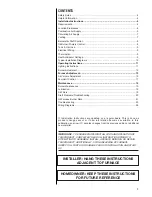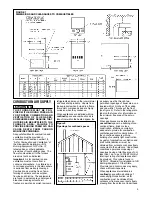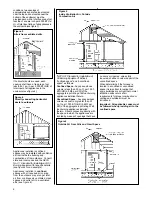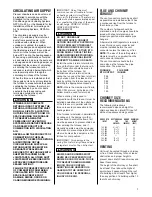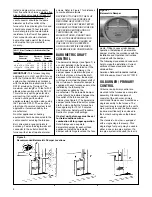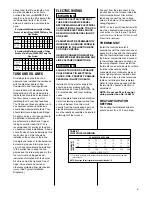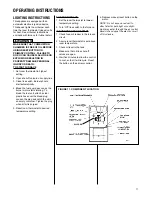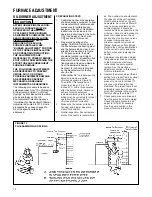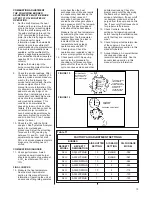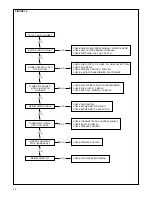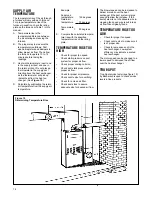
12
FIGURE 12
FLUE SAMPLING LOCATIONS
OIL BURNER ADJUSTMENT
AFTER FURNACE INSTALLATION,
EACH OIL FURNACE MUST BE
OPERATED IN THE HEATING
CYCLE AND PROPER BURNER
ADJUSTMENTS COMPLETED FOR
EACH FURNACE INSTALLATION
FIELD CONDITION. THIS IS
REQUIRED FOR EACH OIL
FURNACE INSTALLED. SEE
“BURNER ADJUSTMENT” PORTION
OF THE FURNACE INSTALLATION
AND OPERATINIG INSTRUCTION.
THE ADJUSTMENTS ARE
NECESSARY TO PREVENT SMOKE,
SOOT, ODOR FROM ENTERING THE
STRUCTURE AND SUBSEQUENT
FURNACE DAMAGE.
THE FOLLOWING ADJUSTMENTS
ARE NECESSARY TO PREVENT
SMOKE, SOOT, ODOR AND
POSSIBLE EQUIPMENT DAMAGE.
AN EXPERIENCED SERVICE
MECHANIC AND RELIABLE
INSTRUMENTS ARE REQUIRED.
The following procedure is based on
guidelines taken from
"The Profession-
al Serviceman's Guide To Oil Heat
Savings" by R.W.Beckett Corporation,
who based theirs on the U.S.
Environmental Protection Agency's
"Guidelines for Residential Oil Burner
Adjustments" printed in 1975. Some
procedures have been changed to
meet the specific units being
addressed.
CAUTION
!
FURNACE ADJUSTMENT
PREPARATION STEPS
1.
Calibrate and check the operation
of all measuring equipment. Follow
the manufacturer's recommended
procedures for calibration and
equipment check out. Calibration
instructions are included in the
operation instructions for the Fyrite
CO2 Gas Analyzer. See Fyrite
CO2 section in this manual.
2.
Prepare the heating unit for
testing. Drill ONE 1/4 inch hole in
the flue between the heating plant
and the barometric damper, if not
already there as shown in Figure
12. If space permits, the hole
should be located in a straight
section of the flue, at least two flue
diameters from the elbow in the
flue pipe and at least one diameter
from the barometric damper.
Another 1/4 inch hole is provided
by the manufacturer for testing
over the fire.
Drill another 1/4
(
hole between the
barometric damper and the
chimney as shown in Figure 12.
The draft at this location must
measure at least -.05 to -.06
inches W.C. within three minutes
after the burner starts. Failure to
achieve this measurement
indicates chimney draft problems
which must be corrected for proper
operation. See Figure 22 for
chimney problem correction.
3.
Make sure the burner air tube, fan
housing, and blower wheel are
clear of dirt and lint.
4.
Nozzle inspection. Annual replace-
ment of the nozzle is recommend-
ed. The nozzle size should match
the capacity of the unit installed.
Nozzle si/ze is listed on the unit
nameplate. An in-line oil filter will
reduce service problems due to
nozzle clogging. It should be
located as close as possible to the
oil burner. Care should be taken to
prevent air leakage into the oil
suction line. Use continuous runs
of copper tubing and use a
minimum number of joints and
fittings. Always use flare fittings.
Refer to the nozzle specifications
for the correct nozzle and spray
pattern, whenever replacing the
nozzle.
5.
Adjustment of electrodes. Adjust
the ignition electrodes according
to the burner manufacturer’s
instructions to assure prompt
ignition. See the electrode
adjustment section in this manual
for more information.
6.
Operate the burner; adjust the air
setting for a proper flame by visual
observation (until no smoke is
present), and run for at least 10
minutes or until operation has
stabilized. If a proper flame is not
obtainable reset the air band and
air shutter settings to the original
factory settings (see table 11).
7.
Check pump pressure. Bleed air
from the pump and nozzle piping.
Check the pump pressure and
adjust to 100 psi, if necessary.
See the pump section in this
manual for more information.
Summary of Contents for LX2000 Series
Page 27: ...27 PARALLEL WIRING UPFLOW OIL FURNACES SCHEMATIC...
Page 28: ...28 HEATING AND COOLING CONTINUOUS LOW SPEED BLOWER SCHEMATICFIGURE 38...
Page 29: ...29 FIGURE 38 FOR MODELS WITH UTEC 1012 925 INTEGRATED FURNACE CONTROL...
Page 30: ...30...
Page 31: ...31...
Page 32: ...32 CM 898...



